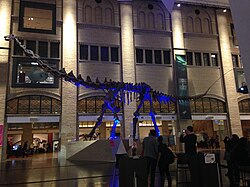Futalognkosaurus
|
Futalognkosaurus Temporal range: Late Cretaceous, 87 Ma |
|
|---|---|
 |
|
| Mounted replica skeleton, Royal Ontario Museum | |
| Scientific classification | |
| Kingdom: | Animalia |
| Phylum: | Chordata |
| Class: | Reptilia |
| Clade: | Dinosauria |
| Order: | Saurischia |
| Suborder: | †Sauropodomorpha |
| Clade: | †Neosauropoda |
| Clade: | †Macronaria |
| Clade: | †Titanosauria |
| Genus: |
†Futalognkosaurus Calvo et al., 2007 |
| Species: | †F. dukei |
| Binomial name | |
|
Futalognkosaurus dukei Calvo et al., 2007 |
|
Futalognkosaurus (/ˌfuːtəˌlɒŋkoʊˈsɔːrəs/ FOO-tə-long-ko-SAW-rəs; meaning "giant chief lizard") is a genus of titanosaurian dinosaur. The herbivorousFutalognkosaurus lived approximately 87 million years ago in the Portezuelo Formation, in what is now Argentina, of the Coniacian stage of the late Cretaceous Period. The fish and fossilized leaf debris on the site, together with other dinosaur remains, suggest a warm tropical climate in Patagonia during this period.
The holotype of the type species, Futalognkosaurus dukei, was originally estimated at 32–34 metres (105–112 ft) in length. In 2008 this was down-sized to 26 metres (85 ft). Holtz estimated it longer at 28 metres (92 ft). An estimate by Gregory S. Paul was that Futalognkosaurus had a maximum length of 30 metres (98 ft). Its long neck contained 14 vertebrae, and was over a meter deep in places, due to its extremely tall neural spines which had a distinctive "shark-fin" shape. The hips were also extremely large and bulky, reaching a width of nearly 3 metres (9.8 ft). The alternate early spelling "Futalongkosaurus" may be found in some press reports and on websites.
...
Wikipedia
